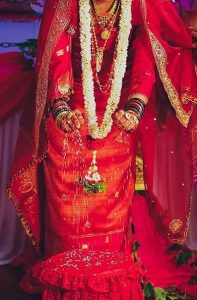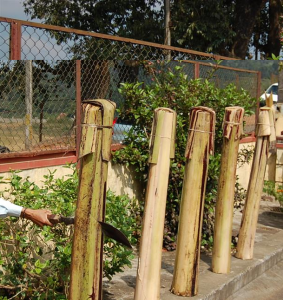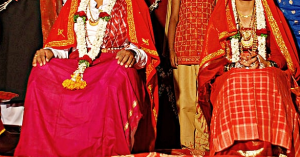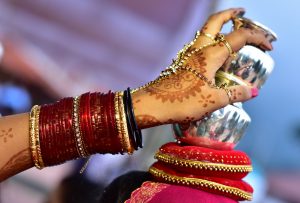Mangala Padathi
Kodava Wedding is one of the fun filled ceremonies which are held for 2 days. In the ancient days, the wedding was held separately for the bride and groom in their respective ainmanes. This Muhurtha is called as ‘Single Muhurtha’. Later, the groom would go to the bride’s house in a procession and there dampathi muhurtha and gange Pooje would be held. This custom is still followed, not often. But, instead of ainmane the ceremony would take place in the wedding hall.
Contents
Ooor Kuduvo
On the day before wedding, all people from the respective families will join and do respective arrangements for the ceremony like putting chappara, cutting pork and vegetables, etc., This is called as oorkuduvo/pandhaal pani/karik murippa/ therane beppo.
On this day, early morning 5 legged pendal is installed in front of the house. One stick of this pendal will be from the tree which produces milk and on top of this either jackfruit leaves or toddy palm leaves are placed. In front of this, Mangoe leaves swag is tied. This pendal is removed after 3, 5 or 7 days.
The groom is dressed with white Kupya, red and gold silk chele and checks vastra. Bride with a coloured saree with long sleeved blouse and vastra tied back at the nape of the neck.
The groom is led by bojakaara to the sacred lamp on the stage where he offers prayer and his mother places a pavala maale around his neck. He then seeks blessings of his parents, elders and his relatives by touching each person’s feet thrice and placing on his forehead.
Similarly, the bride is led by bojakarthi to the sacred lamp on the stage where she offers prayer and her mother ties pathaak around her neck. She then seeks blessings of her parents, elders and her relatives by touching each person’s feet thrice and placing on her forehead.
The traditional kodava volaga will be playing outside the hall and people assembled there will have grand dinner and those who wish to dance will perform to the volaga.
Wedding Day Rituals

On the day of wedding, the dais is decorated, sacred lamp is lit, mats are spread and two mukkalis covered with red cloth are kept at the centre of the dais for the groom and the bride to sit. On either side of two mukkalis thaliyathakki bolcha, kindi and kuth bolchas are placed.
That morning, Bojakaara holds his hand and takes him for ritual shave. Bronze bowl filled with milk and grass is placed and the barber applies this milk on the groom’s face and shaves his facial hair. After this, the remaining milk is poured on the root of milk producing tree. Groom, led by his bojakaara is now taken for ritual bath, where his mother and two married ladies pour one pot of water each on him. Later groom is dressed for the wedding ceremony. He wears white kupya, chele, peta, peeche kathi, katti bale, thodang and a jasmine garland.
Bride, dressed in a silk sari, led by bojakarthi for bale iduva ritual; She sits on the mat spread on the floor and the bangle seller puts glass bangles of various colours with at least one pair of black among them; after this, bojakarthi and 3 or 5 married women will put bangles for her. The ritual bath for the bride is followed by her mother and 3 married ladies. She is then dressed with red silk sari with gold dots and border, long sleeved blouse, Musuk, gold jewellery for ears, neck, wrists, fingers, Kallpilli and a jasmine garland.
Baale Kethuvadh /Baale Mariyaade

A row of nine or more i.e multiples of three, banana stems with flowers on top are placed. Near this, a mat is spread and on top of it Puthari Pache, Odikathi and a pot of water is placed. Poliya is also kept on top of the mat. The person who has taken Baale bembu will sit on the mat facing east. He will take the coconut from the basket and opens it with his peeche kathi. After this, the puffed rice, Coconut pieces and banana are distributed. The girl’s family Aruva will take Odikathi, beetle leaves – aracanut and give it to the person who has taken Baale bembu and says “Baalebembu yeduthavandu”; He will take the beetle leaves – aracanut and will place money and takes the Odikathi back. A maternal uncle of bride and groom, each in turn are given the honour to cut the banana stems.
He takes the odikathi and goes three round around the banana stem; then he will slowly remove the flowers with the tip of odikathi from each banana stem and cuts the stem one by one with a single stroke and then dances joyfully to the beat of valaga music.
After this ritual, Groom walks to the wedding hall holding Gejje Thand and the bojakaara holds an umbrella covered with white cloth over grooms head. The grooms sister or cousin will carry Poliya on her head. As he enters the wedding hall, the bride’s sister or any young girl from bride’s family washes the feet of groom and bojakaara with water. The groom walks on the white cloth spread by washer man. The Poliya is placed under the sacred lamp. The bride’s mother feeds the groom with mixture of milk, rice and sugar.
Dampathi Muhurtha

The Groom after sprinkling rice to the lamp and taking blessings, walks three times around the mukkali and sprinkles rice on it and sits. The same ritual is followed by bride. The Bojakaara sits behind the Groom and the Bojakarthi behind the Bride. The Bride and Groom are now blessed by the people with gifts in a traditional way. At first, they are blessed by their parents, followed by close relatives and other people. At the end of the ceremony, the groom stands in front of his Bride; showers rice on her head, offers a sip of milk from Kindi and gives her cheela pana. He holds her right hand and helps her stand up. The couples will then exchange the garland.
Sammanda Kodpo
The elders from Groom’s and Bride’s side stand in front of the sacred lamp facing each other in a row and will narrate the traditional conversation that grants the rights to the bride.
Batte Thadpo
The bride’s cross cousin who could have married her blocks the path and argues in an entertaining way telling – “I was supposed to marry her and today her wedding is taking place I will not let her go…,” The Grooms side Aruva will somehow convince him and assures that they will look after her very well and offers him gold coin for proof. He takes the gold coin and with that he will add little money and ties that to the tip of bride’s sari.
Neer Edpo / Ganga Pooje

Neer Edpo ritual is taken place after the lunch. This tradition symbolises, the bride becoming a part of Groom’s house in household tasks. The bride removes musuk and ties vastra and is brought near the well. She is then asked to sprinkle rice into the well and pray. After this, she drops betel leaves and aracanuts into the well. Then she breaks coconut with her husband’s peeche kathi and drops into the well. Then the bride draws water and pours it into the four small pots. She will eat little aracanut and then Thombuda is placed on her head and on top of this; two pots one top of another is placed. Two young girls from groom’s family carry a pot, one in front and another behind her. Members of groom’s family dance to the volaga in front of her and bride takes small steps. This continuous for several hours. Once the bride reaches the wedding hall, the pots are kept under the sacred lamps; she sprinkles rice on lamp and takes blessings. After this, she takes the blessings of all the elders gathered there.
Kombarek Kootuvo
Bojakaara will hold Grooms hand and take him to Nellakki Nadubaade. The Groom will sprinkle rice and take blessings of sacred lamp, ancestors and elders gathered there. Then Bojakaara will hold his hand leave him to his room. Bride will be wearing musuk. Groom will remove her musuk and will offer her a gold wedding band. After this, the Bride will take blessings from the groom by touching his feet for three times and placing on her forehead.


Comments
Leave a comment!Login for Post Comment
Last posts